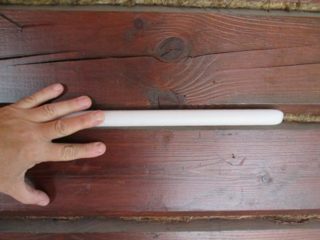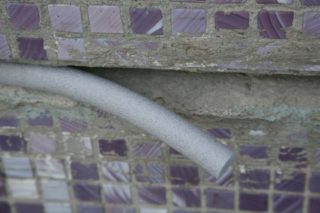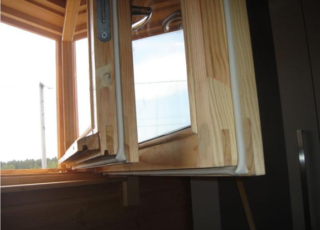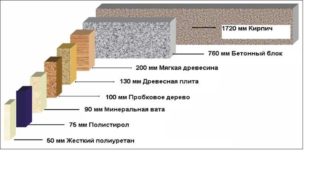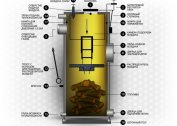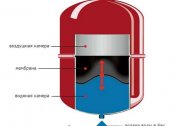Polyethylene foam is a modern material with a bubble structure. It is very light, elastic, does not pass moisture. Insulators are made from it in various forms, including sealing cords.
Properties and characteristics
Foamed polyethylene tows are synthetic shaped products, which are long cords of various thicknesses with a porous, fine-meshed structure. When you touch them, you feel warm and soft. Such harnesses are considered good insulation at the joints, an excellent fixator for the stable position of individual parts.
Exceptional characteristics are:
- Density - 24 - 50 kg / m3, depending on the type of polyethylene used, the manufacturing method.
- The permissible operating range is from -80 ° C to +95 ° C.
- The minimum thermal conductivity is about 0.035 W / m * K, allowing to keep the temperature to the maximum.
- Water absorption - 2.5-3% of the total mass.
- The dielectric constant is about 1.16 (at a current frequency of 10 Hz).
- Chemical inertness in relation to acids, alkali.
- The decomposition period in natural conditions is at least 100 years.
- The permanent deformation after compression by 50% is approximately 15%.
Polyethylene foam tows are considered environmentally friendly and safe for people, because they do not emit harmful substances. They are compatible with other building materials (wood, cement, gypsum, lime, concrete), and react very well to sealants.
Advantages and disadvantages
Insulated tourniquets made of foamed polyethylene have many positive properties that distinguish them from their analogues:
- low thermal conductivity;
- resistance to mechanical stress, return to its original position after damage;
- resistance to chemical influence;
- low hydrophobicity, prolonging the service life;
- elementary and easy installation;
- low cost;
- environmental Safety.
All products made of polyethylene foam are not predisposed to the multiplication of microorganisms and bacteria. For this reason, they have an unlimited guarantee against decay.
The disadvantages include only one characteristic that narrows the scope of application of sealing plaits - high flammability. Sealing material is not recommended for use in places with a high probability of fire.
The combination of all the features, as well as the use of wear-saving innovative production technologies, guarantee that the PES cord will have a long period of operation with full preservation of quality characteristics. Transportation, as well as storage of such products do not cause great difficulties.
Seal Dimensions
Depending on the scope of application, foamed polyethylene tows vary in length and thickness.
Polyethylene foam cords are usually produced:
- in chopped form (3 m);
- in the bays (500 m).
Plaits made of foamed polyethylene are made:
- solid circular cross section with a diameter of 0.8 - 12 cm;
- continuous rectangular sections 9-12 cm wide, 2-2.5 cm thick;
- round with a longitudinal hole in the middle.
Since the polyethylene tourniquet is very light, it holds well on water, so it can be used to teach young children how to swim.
Scope of application
The high insulating characteristics of PES of cords of various types make it possible to widely use them in order to protect against excessive moisture, loud noise, and heat loss. They can protect the details of most building structures from the effects of condensate, corrosion, and save money on heating a house.
PES cords of different thicknesses have the following purposes:
- diameter 6 - 12 mm is suitable for arranging industrial floor coverings in order to fill expansion joints;
- diameter 2 - 20 mm is often used for thermal insulation of joints, crevices of window frames, balconies and external doors;
- diameter 20 - 60 mm is used during the construction of walls of buildings in order to fill the seams between the panels, as well as the gaps between the logs in wooden buildings.
Construction, repair, reconstruction of premises:
- for reliable insulation of joints of individual parts of building structures;
- soundproofing of different types of walls, ceilings;
- as a sealant during installation of windows, doors.
In factory mass production:
- devices, apparatuses;
- ventilation, refrigeration units;
- cars;
- sports equipment, rescue equipment;
- footwear, orthopedic products;
- leather products, upholstered furniture (for upholstery), etc.
In domestic conditions for fixing and warming:
- when packaging goods to protect against external mechanical damage during transportation;
- as a reliable sealant during installation of household air conditioners;
- in the design of private underground communication devices;
- for insulation of windows and doors (sealing of individual elements) for the cold winter period;
- interior decoration.
Regardless of the area of use of the sealing cords, the application technology is the same:
- The tourniquet is laid in a separate seam. Mechanical compression averages 30%. It is important to ensure that the part of the joint remaining for filling with sealant is equal to its width or correlates with it in a proportion of 1: 2.
- Sealing the cord is performed in an even layer, without the formation of gaps, bubbles. To make the appearance of the object impeccable, first masking tape is placed on the edges of the seam. It is removed immediately after alignment of the sealant.
If the amount of necessary work is significant, instead of masking tape it is recommended to use a special tool for smoothing, which will speed up and simplify the work process.
Comparison with other materials
Polyethylene tow has heat-insulating properties, far exceeding the capabilities of other popular building materials.
A strip with a diameter of 10 mm will replace:
- 10 cm of wood;
- 3 cm of mineral wool;
- 15 cm of brick and concrete layer;
- 1.7 cm of foam PVC-1;
- 2 cm fiberglass plate.
The sealing harness does not rot, does not get wet under the influence of moisture, and rust does not appear on it. Unlike other materials with a natural base, it is not affected by the fungus.
A cord made of foamed polyethylene is the most acceptable option among the materials used to protect building structures from damage and negative influences.

